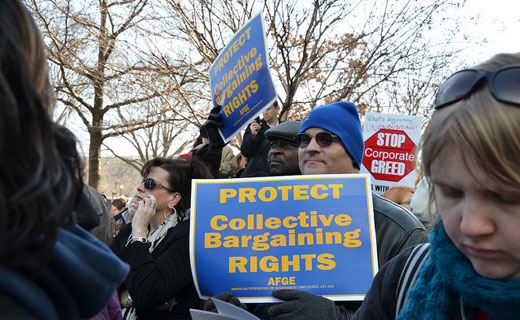
WASHINGTON – The number of union members nationwide declined by 398,000 from 2011 to 2012, the Bureau of Labor Statistics says in its latest report. But there are many qualifications and caveats, the BLS economist who analyzes the data adds.
The agency reported 14.4 million people were union members last year, down from 14.8 million in 2011. Some 35.9 percent of public sector workers were unionists in 2012, even though the number of public sector unionists fell by 224,000 in a year. Union density in the private sector declined to 6.6 percent the BLS survey said. There were 7.3 million public-sector unionists, a majority, in 2012.
Unions lost almost three times as many women (-288,000, to 6.47 million) as men (-111,000, to 7.895 million) in a year.
BLS analyst Jim Walker told Press Associates Union News Service the most definite thing that can be drawn from the numbers is the long-term trend of declining union density in the U.S.
Overall, Walker added, the decline in union density reflects the changing nature of the economy. He noted the survey that produces the union data also generates the monthly employment and jobless numbers. It has shown a consistent long-term shift away from construction and manufacturing to service jobs, many in less-union-dense industries, such as finance, insurance and real estate (1.9 percent unionized).
State-level and industry-level figures – such as Wisconsin’s 2.1 percent union density decline, where right wing GOP Gov. Scott Walker banned collective bargaining for 200,000 state and local workers – are based on samples too small to reach definitive conclusions, Jim Walker added. The survey covers 60,000 households nationwide, in rolling groups, so the same households are not surveyed every month.
“I think the decline” in states like Wisconsin “might have more to do with construction projects being completed or factories closing down” than with specific political policies, BLS’ Walker said.
The survey reported the number of state and local government workers nationwide – the targets of the right-wingers – declined by 187,000 last year, to 6.372 million. Almost all was in local government, down 182,000, to 4.4 million.
BLS said 41.7 percent of local government workers were union members in 2012, down from 43.5 percent in 2011. Percentages were also high among teachers (35.4 percent), and protective service workers (34.8 percent). The most heavily unionized private sectors were utilities (24.7 percent) and telecommunications (15.6 percent).
One of every seven construction workers (13.2 percent) and one of every nine factory workers (9.6 percent) were union members last year, though BLS’ Walker again cautioned against drawing specific conclusions from such small samples.
Union contracts covered another 1.6 million workers – half in the public sector and half in the private sector – who are not members. Right-to-work laws, such as Indiana’s, can drive that figure up.
In a prepared statement, AFL-CIO President Richard Trumka said “working women and men urgently need a voice on the job today, but the sad truth is it has become more difficult for them to have one,” as the data show.
“Our still-struggling economy, weak laws and political as well as ideological assaults have taken a toll on union membership, and in the process have also imperiled economic security and good, middle-class jobs,” he continued.
Then he pivoted to the positive, saying unions “understand these challenges offer real opportunities…to reshape the future.” He cited coalitions workers are building in communities, with young people and immigrants and in fights against Right Wingers. He also claimed workers are “organizing in innovative ways” to create “a new movement for the future and to creating good jobs and an economy that works for all.”
As in prior years, the union movement is concentrated in the Northeast, the Great Lakes States and the Pacific Coast. It’s still weak in the Southeast and Southwest. North Carolina stayed dead last in union density, at 2.9 percent, unchanged from the year before, though its union numbers rose by 7,000, to 112,000. New York, at 23.2 percent, was first again, but it’s down 0.9 percent and 65,000 members from the year before.
BLS calculated about half of all union members lived in seven states: California, (2.49 million), New York (1.841 million), Illinois (801,000), Pennsylvania, (734,000), Michigan (629,000), New Jersey (611,000), and Ohio, (604,000). Numbers and density declined in all those states except New Jersey, where density was unchanged. There were two notable union increases in the union-weak areas, the BLS calculated: A 1.1 percent increase in Kentucky, to 10 percent, and a 65,000-person, 0.5 percent rise, to 5.7 percent density, in Texas.
Photo: Attacks on collective bargaining rights by GOP governors around the country are one of many contributions to the decline in union membership. Flickr












Comments